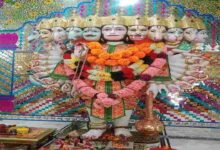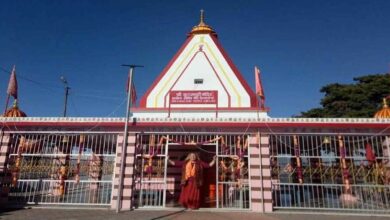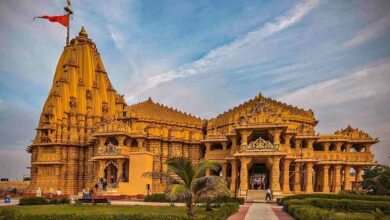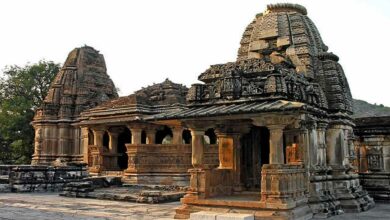10 Famous Shri Ram Temples: Apart from Ayodhya, Lord Shri Ram is also present in these 10 places of India, huge crowd of devotees has gathered
10 Famous Shri Ram Temples: People of several faiths and sects live in India, which is a religious nation. Lord Rama is revered in Hinduism as Vishnu’s seventh incarnation. In Indian culture, he is regarded as the perfect man because of his life and actions, which are recounted in the Ramayana. Many large, historic temples have been built in the name of Lord Rama across India as a result of the people’s deep love and confidence in him. These temples are not only home to the idols of Lord Rama, but they are also connected to the myths and local mythology surrounding him.
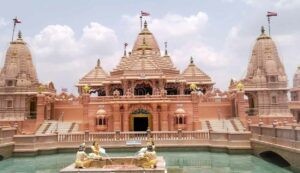
While some temples were constructed by subsequent monarchs and followers, others are said to have been constructed during the era of Lord Rama. These temples’ stunning architecture and relics showcase the artistic and architectural prowess of ancient India. The Ram Janmabhoomi Temple in Ayodhya, the Kalaram Temple in Nashik, the Ramanathaswamy Temple in Rameswaram, and the Sri Ram Temple in Triprayar are some of the most important temples dedicated to Lord Rama. Millions of devotees visit these temples in hopes of receiving darshan and having their desires granted. In addition to their religious importance, these temples are popular tourist destinations and spiritual hubs.
10 Shri Ram Temples
Here is a list of some famous Ram temples along with their location:
S.NO |
Temple |
Location |
|---|---|---|
1 |
Triprayar Sri Ram Temple |
Kerala |
2 |
Kalaram Temple |
Nashik |
3 |
Sri Sita Ramachandra Swami Temple |
Telangana |
4 |
Kanak Bhawan Temple |
Ayodhya |
5 |
Shri Ram Teerth Temple |
Amritsar |
6 |
Kodanda Ramaswamy Temple |
Chikmagalur |
7 |
Ramaswamy Temple |
Tamil Nadu |
8 |
Raghunath Temple |
Jammu |
9 |
Ram Raja Temple |
Madhya Pradesh |
10 |
Shri Ram Temple |
Ayodhya |
1. Thriprayar Sri Ram Temple (Kerala)
The Triprayar Sriram Temple, located in the Thrissur district of Kerala, is an old Hindu temple. It is dedicated to Lord Rama, the seventh incarnation of Vishnu. The Triprayar River, locally known as Dakshina Sarayu, is where the temple is located.
Chaturbhuj Vishnu holding a conch, chakra, bow and garland in his four hands, is the main idol of the temple. It is said that Lord Krishna worshipped a similar idol in Dwaraka. The idol was found by some fishermen in the Chettuva district of Kerala when it was submerged in water after Krishna’s ascension to heaven, and the local ruler Vakkayil Kaimal built a temple in its honor at Triprayar.
Apart from Lord Rama, Lord Hanuman is also worshipped in the temple along with the idols of Dakshinamurthy Shiva, Ganesha and Krishna. The temple has fine wood carvings. The conical peak of the circular sanctum is coated with copper. The walls are beautifully painted. The 24 panel wood carvings on the namaskara mandapa depict the Navagrahas.
The two main festivals of the temple, Ekadasi and Pooram, are celebrated in the months of Karthika and Chaitra, respectively. Devotees from all over the country gather on the day of Ekadasi to watch the parade of Rama with 21 elephants. The temple is famous for its ability to drive out evil spirits.
2. Kalaram Temple (Nashik)
There is a famous Hindu temple known as Kalaram Temple in Panchvati Mohalla in Nashik. Peshwa Sardar Rangrao Odhekar built this temple in 1782 and dedicated it to Lord Rama. The temple is called Kalaram because it houses an idol of Lord Rama made of black stone.
According to legend, a farmer found this idol in a nearby lake while plowing the field and gave it to Sardar Odhekar. Odhekar built this temple to keep the idol safe. Apart from Lord Rama, the sanctum sanctorum of the temple also houses idols of Mata Sita and Lakshmana. It is said that Lord Rama stayed here with Sita and Lakshmana during his exile, so this temple has great religious significance for Hindus.
The festivals of Ram Navami, Dussehra and Chaitra Padwa are celebrated with great pomp in the Kalaram Temple. During this time, parades are taken out around the city and the idol of Lord Rama is decorated. The temple is open from 5 am to 10 pm. Due to its grand architecture, serene atmosphere, and religious significance, the temple welcomes thousands of visitors and devotees every year.
3. Sri Sita Ramachandra Swamy Temple (Telangana)
Bhadrachalam in Telangana houses a famous Hindu temple known as Sri Sita Ramachandra Swamy Temple. Lord Rama and his wife, Sita, are the objects of devotion here. Considered to be one of the holiest pilgrimage sites in South India, the temple is located on the banks of the Godavari River.
According to legend, Lord Rama had assured his disciple Bhadra Rishi that he would be saved. After the Rama avatar, Vishnu once again took the form of Rama and granted salvation to Bhadra Rishi. Thus, in honor of Bhadra, the place was called Bhadrachalam. The temple was built in the 17th century by the local tehsildar Kancharla Gopanna, also known as Bhakta Ramadas. Using money from the state treasury, he built the beautiful temple and made Bhadrachalam an important religious center.
The idols of Rama, Sita and Lakshmana are the main objects of worship in the temple. Other Hindu deities, including Gavan Shiva, Narasimha and Vishnu, are also represented by idols. During Rama Navami, the place is packed with people. Another name for Bhadrachalam is “South Ayodhya.” It is said that Rama, Sita and Lakshmana spent a major part of their exile in this ashram.
4. Kanak Bhawan Temple (Ayodhya)
The grand and ancient Kanak Bhawan temple is located in the Ram Janmabhoomi complex in Ayodhya. This structure is said to be the private palace of Lord Rama and Mata Sita. It is said that this structure was a wedding gift from Queen Kaikeyi to Mata Sita.
This temple is famous for its enchanting structure. The temple has many minarets and pillars and is constructed in the Shikhara style.
Kanak Bhawan temple also has mythological significance. It is said that Mata Sita and Lord Rama spent their entire domestic life here. The pond located next to the temple is named Sita Kund. If you are coming to Ayodhya, then definitely visit Kanak Bhawan temple. You will undoubtedly be impressed by this temple.
5. Shri Ram Tirth Temple (Amritsar)
The Shri Ram Tirth Mandir was built near the city of Amritsar to commemorate the birthplace of Luv-Kush, the twins of Lord Rama and Goddess Sita. Made of yellow limestone, the temple was built in the Ramayana period when Sita took refuge in Valmiki’s ashram after Rama left. It is said that this is where Rama’s Ashwamedha army fought with Luv and Kush. Pilgrims visit the twins’ Gurukul, an architectural marvel, which is a part of the temple complex.
A fortnight after Diwali, a five-day festival is celebrated at the historic temple, with about a lakh visitors coming to seek blessings. On the night of the full moon, devotees swim in the historic pond next to the temple.
On the night of the full moon, a custom called Tulla Toran is observed in which burning diyas made of ghee and kneaded dough are immersed in water. It is said that following this custom pleases Lord Rama and liberates one from all sins. There is a strange concept that a pilgrimage is considered incomplete if one does not give food or cash to the needy.
6. Kodanda Ramaswamy Temple (Chikmangaluru)
A famous Hindu temple in Chikmagalur is the Kodanda Ramaswamy Temple. The Tungabhadra River is nearby. Lord Rama, an incarnation of Lord Vishnu, is the main deity of this temple. The main sanctum of this temple houses idols of Lord Rama, his brother Lakshmana and Goddess Sita. The same rock has been used to make the idols of each deity.
According to legend, Lord Rama built this temple at the same place where he coronated the new monkey king, Sugriva. The sanctum of the temple makes it special. Devotees can see Sugriva bowing before Lord Rama, while other Lord Rama temples show Lord Hanuman bowing before him. The entire temple is a brilliant blend of Dravidian and Hoysala architectural styles. Both the exterior and interior have elaborate carvings.
7. Ramaswamy Temple (Tamil Nadu)
One of the largest temples dedicated to Lord Rama in India is the Ramaswamy Temple. As is well known, Lord Rama is an incarnation of Mahavishnu and is present in the sanctum sanctorum of the temple along with Sita and his golden robe. This temple is particularly special because it depicts Lord Rama standing with a bow and arrow, his brothers Lakshmana and Bharata holding umbrellas and Shatrughna holding a fan. Hanuman can be seen praising Lord Rama while playing the veena.
In most other Rama temples, Bharata and Shatrughna are not visible in the sanctum sanctorum. The Mahamaham festival, which takes place once every twelve years, is associated with this temple. Raghunatha Nayak built the temple in the sixteenth century. It has a huge rajagopuram and a 64-pillared mandapa with numerous paintings depicting the life story of Lord Rama. Around 219 wall murals depicting every nuance of our grand epic Ramayana can be seen here. The sanctum sanctorum, Alwar Sannidhi, Srinivasa Perumal Sannidhi, Gopalan Sannidhi and other deities are part of the temple. Six rituals are performed daily at the temple, which are performed at different times from 5 am to 9 pm. Sri Rama Navami is celebrated with great pomp at this place. It is understandable why this huge Ram temple is called Dakshina Ayodhya or Ayodhya of South India.
8. Raghunath Temple (Jammu)
Known as the largest temple complex in North India, the Raghunath Temple is located in the heart of Jammu, not very far from the Jammu airport. Each of the seven temples that make up the Raghunath Temple complex has its own shikhara. Lord Rama, an incarnation of Lord Vishnu, is the presiding deity of the Raghunath Temple in Jammu.
Maharaja Gulab Singh, the founder of the state of Jammu and Kashmir, started the construction of the Raghunath Temple in 1835 AD. In 1860, his son Maharaja Ranbir Singh developed it.
Each of the seven temples that make up the Raghunath Temple complex attracts visitors with its magnificent grandeur. Each of these seven huge temples has tall shikharas, locally known as shikharas, on top of them. An image of Lord Hanuman and a photo of Maharaja Ranbir Singh are displayed at the entrance of the temple. Other temples show Lord Vishnu in several incarnations. Another temple dedicated to Lord Surya has several forms of the Lord. The inner walls of this famous holy place of Jammu are covered with gold sheets on three sides. The temple also has a gallery that houses several lingas or phallic figures of Lord Shiva, with Shaligrams installed on top of them.
9. Ram Raja Temple (Madhya Pradesh)
Ram Raja Temple is a unique temple dedicated to Lord Rama, which is located in the city of Orchha in Madhya Pradesh. This temple is worshiped as a king and is famous for both its grand construction and religious significance.
This temple resembles a grand palace. The sanctum sanctorum of the temple houses idols of Lord Rama, Sita, Lakshmana and Bharat. Lord Rama is seen taking the form of a king with swords and a crown. The grandeur of the temple is further enhanced by the pillars and huge monuments around it.
The walls and ceilings of the temples have amazing figures and sculptures that depict the life of Lord Rama. The followers of this lore are immersed in the leelas of Lord Rama.
10. Ram Temple (Ayodhya)
One of the most important religious places in India is the magnificent Ram Temple, which is situated above Ram Janmabhoomi. This temple was built at the birthplace of Lord Rama, which is revered.
The Ram temple is said to have been built around the 12th century. Babur destroyed this temple in 1528 and built the Babri Mosque in its place. In 1992, the Babri Masjid was destroyed by Hindu karsevaks. The Supreme Court awarded Ram Janmabhoomi to the Lord in 2019. Prime Minister Narendra Modi performed the Bhoomi Pujan of the temple on August 5, 2020.
The architecture of the Ram temple is Nagar. The temple will have a fifth peak on three floors. The sanctum sanctorum of the temple contains idols of Lord Rama, Sita, Laxman and Bharat. Pink sandstone from Bansi Parvatpur in Rajasthan is being used in the construction of the temple. For faith, the Ram temple represents religion. This temple is the center point of devotion to Lord Rama. The architecture of the temple represents the rich cultural heritage of India.
In Short:
There are temples dedicated to Lord Rama in many Indian states. Apart from being the center of Hinduism, these temples also have religious and cultural significance. When devotees visit these temples, they get inspiration from the life and teachings of Lord Rama. Apart from reading our other articles, if you liked this particular article about the ten main temples of Lord Shri Rama, please share it with your friends and family.
Frequently Asked Questions
Q. What is the birthplace of Lord Rama?
A. Lord Shri Rama was born in the city of Ayodhya in Uttar Pradesh during the Treta Yuga.
Q. Who were the parents of Lord Rama?
A. King Dasharatha and Queen Kaushalya were the parents of Lord Rama.
Q. How many brothers did Lord Rama have?
A. The answer is that Lord Shri Rama was the eldest of his three brothers, Laxman, Bharat and Shatrughna.
Q. Why was Lord Rama sent to exile?
A. Lord Rama had to spend 14 years in exile as a result of the conspiracy of Mother Kaikeyi.
Q. What principles did Lord Rama follow?
A. Lord Rama was named Maryada Purushottam. He was an ideal brother, husband, son and king.
Q. What was the duration of Lord Rama’s reign?
A. Lord Rama ruled for eleven thousand years.
